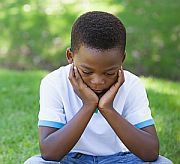- Tips for Spending Holiday Time With Family Members Who Live with Dementia
- Tainted Cucumbers Now Linked to 100 Salmonella Cases in 23 States
- Check Your Pantry, Lay’s Classic Potato Chips Recalled Due to Milk Allergy Risk
- Norovirus Sickens Hundreds on Three Cruise Ships: CDC
- Not Just Blabber: What Baby’s First Vocalizations and Coos Can Tell Us
- What’s the Link Between Memory Problems and Sexism?
- Supreme Court to Decide on South Carolina’s Bid to Cut Funding for Planned Parenthood
- Antibiotics Do Not Increase Risks for Cognitive Decline, Dementia in Older Adults, New Data Says
- A New Way to Treat Sjögren’s Disease? Researchers Are Hopeful
- Some Abortion Pill Users Surprised By Pain, Study Says
Suicide Rate Up Among Young Black Children in U.S.


Suicides among black American children have increased in recent years, while fewer white children are killing themselves, a new analysis finds.
The odds of any children in the age group 5 to 11 taking their own life remain small. But young black children are three times as likely to do so as whites, the researchers said.
“While overall suicide rates in children younger than 12 years in the United States remained steady from 1993 to 2012, there was a significant increase in suicide rates among black children and a significant decrease in suicide in white children,” said Jeffrey Bridge, of the Research Institute at Nationwide Children’s Hospital in Columbus, Ohio.
“Many factors affecting black youth, including increased exposure to violence and traumatic stress, early onset of puberty, and lower likelihood to seek help for depression, suicidal thoughts and suicide attempts may be contributing to the disparity, ” Bridge added. “But the specific impact of each of these risks is unclear.”
Hanging/suffocation, the leading suicide method, accounted for more than three-quarters of the total suicide deaths. Guns were used in nearly 20 percent of cases, the study found.
Bridge and his colleagues published their findings in the May 18 online edition of JAMA Pediatrics.
To explore trends in youth suicide, the investigators reviewed 20 years of information from U.S. Centers for Disease Control and Prevention databases.
The team found that roughly 33 boys and girls between ages 5 and 11 died by suicide every year on average. That translated into a stable rate of a little more than one child suicide a year for every 1 million American children.
But when broken down along racial lines, the nation’s suicide portrait looked far more complicated.
For example, while the suicide rate among young white children fell from 1.14 per 1 million in 1993 to 0.77 per 1 million by 2012, the same figure rose among young black children from 1.36 per million to 2.54 per million.
The trend appears to be driven largely by boys, who make up 84 percent of youth suicides overall. The suicide rate among black boys nearly doubled — jumping from 1.78 to 3.47 per million — during the study period, while among white boys it dropped from 1.96 to 1.31 per million.
Bridge said future research will need to continue to track the trends, with the hope of better understanding the underlying factors at work.
Meanwhile, “parents and health care providers need to be aware that children under the age of 12 can and sometimes do think about suicide,” he stressed.
“It is important to ask children directly about suicide if there is a concern about a child,” Bridge said. “For example: ‘Are you having thoughts about killing yourself?’ The research has shown that asking children directly about suicide will not trigger subsequent suicidal thinking or behavior. It does not hurt to ask.”
Sarah Feuerbacher, director of the Southern Methodist University Center for Family Counseling in Plano, Texas, seconded the notion that “it is always a good idea to ask.”
Feuerbacher said, “Starting the conversation with someone you think may be depressed or even considering suicide helps in many ways.” This may help a child feel less alone and less isolated, while offering the opportunity to trust and confide in other people and/or alternative options, she suggested.
In the case of older kids, Feuerbacher added, “most teens that get help for their depression go on to enjoy life and feel better about themselves, their relationships, and their environments in which they live.”
Dr. Andrew Adesman, chief of developmental and behavioral pediatrics at the Cohen Children’s Medical Center of New York in New Hyde Park, N.Y., stressed that, despite some concerning trends, suicide among young children remains exceedingly uncommon.
“Although suicide is indeed a major public health concern for adolescents, it is very rare — literally ‘one in a million’ — for children ages 11 and under,” Adesman said.
More information
There’s more on youth suicide risk and prevention at the U.S. National Association of School Psychologists.
Source: HealthDay
Copyright © 2024 HealthDay. All rights reserved.










